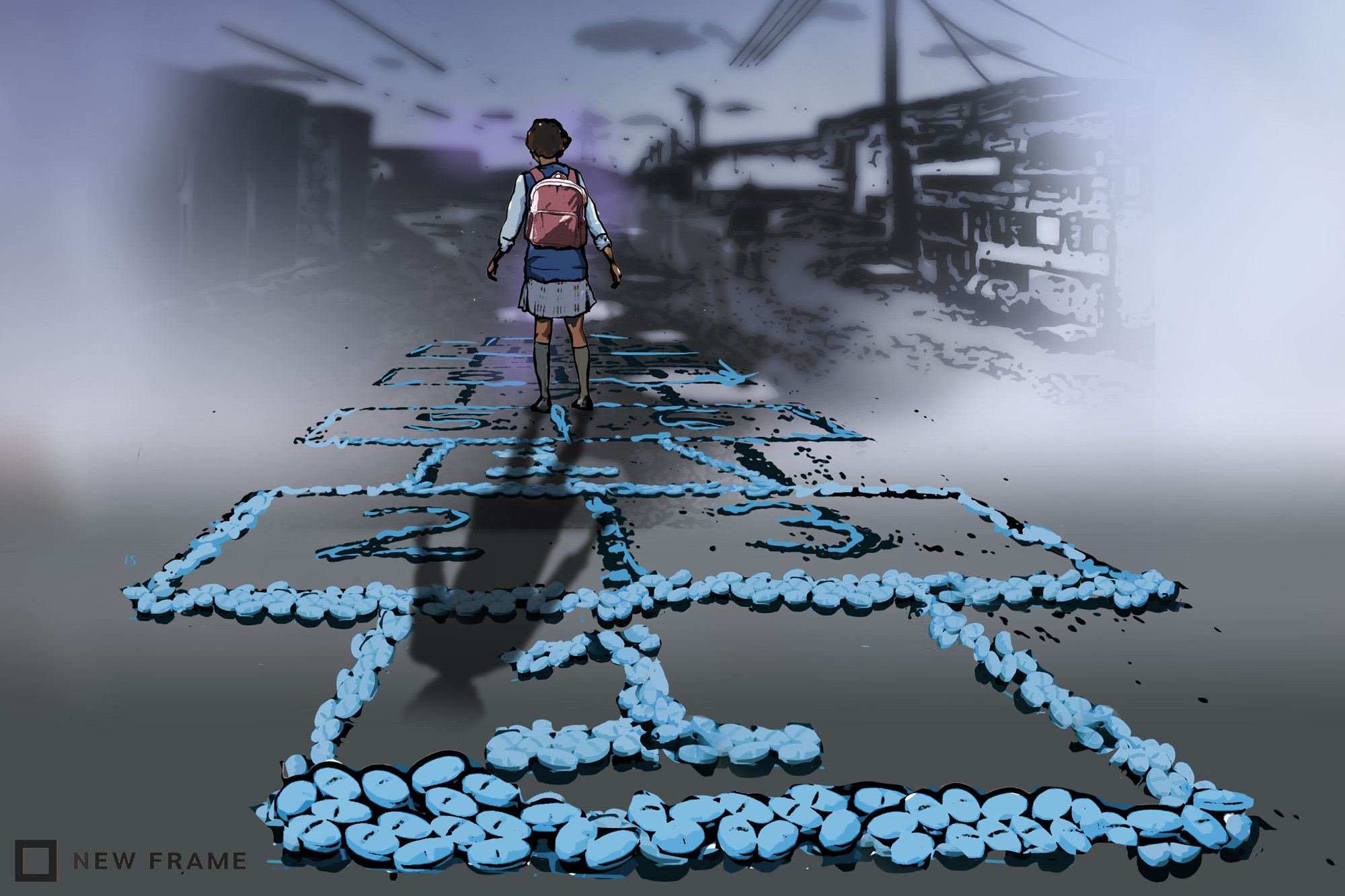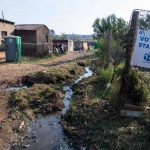Prescription drug poses new threat to youths
Learners turn to anti-anxiety medication to manage stress but punishment remains the state’s primary intervention.
Author:
26 August 2019

Nozipho*, a confident grade 12 learner, is keen to talk about drugs. Her brother committed suicide after becoming hooked on whoonga (low-grade heroin). She is now concerned for a friend who tells her he wants to “carry on with my business”. By this he means he sells drugs at their Umlazi school; he misses exams to avoid getting promoted to a higher grade.
Xanax, a drug prescribed to treat anxiety, is a goldmine for Nozipho’s friend. The tablet is nicknamed “Zen”, “Zanele”, “Zandile”, “Xany”, “Xan” or “Baby blue mylans”. It is typically bought for R5, which, to put in context, is the price of two “loose” cigarettes. Over the past two years, Xanax use has exploded not just in Durban schools but also, some reports suggest, across the country.
“You zwang,” said 17-year-old Ntombi, who lives in Umlazi Township but attends school outside, “goofed [from weed] is when you are high, but when you are zwanging you are at a point when you can’t even text on your phone.” She said that the substance is consumed “like a Tic Tac” and that on a Friday as many as 50% of learners in her class are zwanging. “You are like a zombie,” reports David, who attends a school in a middle-class suburb.
Related article:
In July and August, I spoke with 39 groups of learners at 15 high schools across South Durban. Every group described the same two top drugs at schools: weed/cannabis and Xanax. What learners call Xanax is usually a generic version of alprazolam, the anti-anxiety benzodiazepine. These and other drugs move regularly across the city, like schoolchildren themselves today.
“Drug”, a word that conjures up both white-coated technicians and gun-toting gangsters, drips with moral messages. In essence though, a drug is any substance, whether legal or illegal, with physical or psychoactive effects. Historically, most illicit drugs in KwaZulu-Natal were produced and sold in a decentralised way, partly out of necessity. Think of the shebeen queens who dodged apartheid’s police to brew and sell beer and the numerous sellers of locally grown weed.
Mandrax (buttons or ingidi) is controlled by larger dealers, though it has faded in popularity among the young. Other drugs such as ecstasy (qo), cocaine (ntashi) and alcohol are not associated with school but with nighttime parties. Cough medicine with codeine, mixed with a fizzy drink to make lean, was popular for a while, though pharmacies have cracked down on its sale.
Related article:
The past two decades have witnessed a reshaping of the drug world. South Africa has emerged as a major node in a southern route that moves heroin from Afghanistan via East and southern Africa to Europe and the United States. In Durban, heroin dealers spearhead a growing drug network, with major players not afraid to use violence to protect their territory.
What is significant about the small, light blue Xanax pills is that they are now linking the doors of learning to the gates of drug distribution.
Xanax, compared to whoonga, has far fewer withdrawal symptoms, and so its trade doesn’t appeal to some of the most established drug dealers. Yet it can still create new circles of violence that rock schools. Mrs Slindile Bhengu, a deputy principal at an Umlazi school, exudes an energetic vibe, but much of her commitment is diverted from the classroom to addressing social issues including drugs.
“The supplier will give it to kids here,” she says. “The supplier wants to control all of the schools in the section. And whenever he hears that someone else is dealing, he will wait for them at the gate and there will be a fight.”
Drugs, schools and craving secure work
Xanax’s popularity among young people around the world is reflected in the lyrics of musicians such as Travis Scott and Drake, who sing “I did half a Xan, 13 hours ’til I land / Had me out like a light, ayy, yeah.”
Yet learners at schools say the biggest reason drugs are used is to relieve stress. This can be associated with schoolwork and exams, but it also stems from poverty or family problems. Nozipho says, “When my mother died, then I started [smoking weed]. It helps me sleep.” Some learners say that certain strains of weed allow them to push out problems and concentrate at school. Xanax can be taken alone or mixed with weed.
Whoonga use is particularly rife among those who attend schools in the poorest parts of the city. Around half of the 50 whoonga users interviewed last year became hooked while attending school. Most are young men who struggled at school and dropped out in grades 9 to 12.
Nompumelelo, 17, is chatting with us in a township school’s small computer room. Ugly metal bars have been attached to the inside of the roof to prevent break-ins. A chirping bird flies in and out through a broken window. Nompumelelo’s brother dropped out of school so that he could phanta (hustle) and earn regular bits of cash, for instance by cleaning yards or cars, to buy R25 capsules of whoonga. So desperate was the craving for this heroin-based drug that one day she came home to find him and a friend removing their fridge to sell.
Drug dealers’ fast cars and, just as important, support to families and neighbours, can create powerful role models. Sifiso, a grade 12 learner from Umlazi who takes Xanax, puts it like this: “You see graduates who stay at home, they got degrees and they stay at home, you see [rich] drug dealers, they have no degrees.”
Every year, 400 000 learners pass the matriculation exam, but youth unemployment sits at 56%. Around the world, the weakened connection between education and decent work feeds chronic anxiety in educational institutions.
Why we should worry about prescription drugs
In the United States, the “war on drugs” directly targeted and criminalised black communities. In contrast, the powerful pharmaceutical industry was given free rein to push opioids as well as anti-anxiety and anti-depression drugs. Several US states have now brought lawsuits against big pharma, accusing the industry of hiding the addictive nature of opioids.
In KwaZulu-Natal, underhand sales by those working at pharmacies and hospitals appear to be a major source of illicit prescription drugs. The cheap price of Xanax means that dealers high up the food chain, or smaller buyers, rely on learners to sell hundreds of pills in schools.
Related article:
There is another major reason for concern: in North America and Europe the headline drug story of the last decade is the thousands of deaths from prescription drugs, especially synthetic opioids. Fentanyl, which can be 50 times stronger than heroin, is frequently mixed with heroin by dealers to boost profits. When too much is added, the result is deadly. In the United States alone, there are tens of thousands of fentanyl-related deaths annually.
This raises a frightening scenario. What if fentanyl or a similar synthetic opioid were mixed by dealers with whoonga? The country has become a node in the international drug trade. Heroin and illicit prescription drugs are already in circulation. Though some police officers work with community interests in mind, others take bribes that sustain the local drug industry.
Action
In the 1990s, activists were quick to mobilise when HIV/AIDS exploded in KwaZulu-Natal. The Treatment Action Campaign highlighted the social causes of HIV and fought the state’s “denialism”. However, there is no comparable social movement linking drug use to societal inequalities. Bhengu says that she has tried to bring non-governmental organisations into the school to talk about drugs, but their funders want them to prioritise HIV/AIDS education.
Despite the frightening rise of whoonga, there are only two public rehabilitation centres in the entire province, and they don’t use opioid substitution drugs such as methadone. A Durban University of Technology pilot project is one of the few places where whoonga users have been able to access care. Punishment, rather than treatment, remains the primary state intervention for substance abuse.
Of course, drugs are contested in everyday life and go in and out of fashion. Whoonga continues to take a huge toll on families in KwaZulu-Natal, but learners can shrug it off as a dead-end drug, in the same way that crack cocaine lost popularity in the 1990s in the United States.
At the same time, the situation could get much worse, especially if the rise of pharmaceutical drugs continues. The Xanax explosion is just another reason behind the need to improve poorly performing schools and strengthen the link between education and the world of work.
*All names are pseudonyms.



